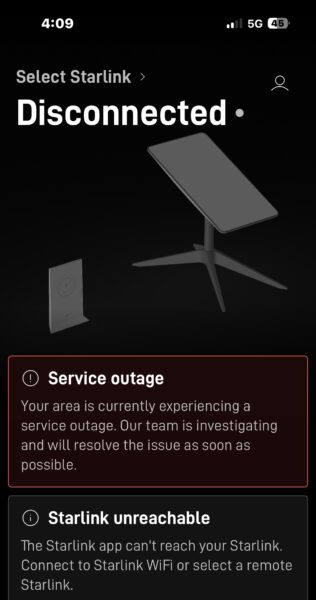The widespread outage of SpaceX’s Starlink network, which affected users around the globe on 24 July, could have impacted operations at Runway Girl Network if we relied wholly on the Ku-band Low Earth Orbit (LEO) satellite service for connectivity. Luckily, we don’t. And so, when the Starlink-powered Wi-Fi went down — for several hours in our particular neck of the woods — a back-up connection saved the day.
Many other Starlink subscribers were not as lucky. Popular flight tracking web site Flightradar24, which aggregates data from multiple sources including crowdsourced information, confided on X that it lost about 5% of its data feeds during the Starlink outage. And it warned that “some regions might have reduced ADS-B/MLAT coverage” as a result.
Even after SpaceX vice president of Starlink engineering Michael Nicolls reported on X that Starlink had “mostly recovered from the network outage, which lasted approximately 2.5 hours,” some users reported otherwise, and took to X to request a refund for the day, citing a loss of business.
 Mistakes happen and, according to Nicolls, the 24 July outage was due to a “failure of key internal software services that operate the core network.” It’s certainly not the first time a software-related issue has created LEO network dead zones, as Eutelsat OneWeb will attest.
Mistakes happen and, according to Nicolls, the 24 July outage was due to a “failure of key internal software services that operate the core network.” It’s certainly not the first time a software-related issue has created LEO network dead zones, as Eutelsat OneWeb will attest.
But the Starlink event serves as yet another reminder of why network resiliency is so important for enterprises as well as mobility stakeholders, especially those in military and defense. According to Reuters, Starlink systems used by Ukrainian military units were affected by the outage.
What happens when our fighting forces, who are using this product in war zones cannot connect? What happens when lifesaving search and rescue teams are plunged into a connectivity crisis? These are just some of the questions being asked by Kymeta, which provides flat panel antenna hardware to the military.
For Kymeta CEO Rick Bergman, the Starlink outage underscores why the deployment of multi-orbit, multi-network products built for warfare are a fundamental necessity for organizations and governments.
“Globally the call for resilient, secure communications is louder than ever. The vulnerabilities exposed by recent events worldwide have shown just how fragile traditional infrastructures can be,” Bergman said.
“Regardless to the nature of disruption, the capacity to quickly pivot and maintain communications is non-negotiable. For governments and enterprises, the ability to seamlessly switch between satellite orbits and terrestrial networks is fundamental for operational success.”
Should similar logic be applied in commercial aviation? Equipping aircraft with broadband connectivity is not just about ensuring passengers can be entertained with streaming video and social media in flight. IFC connects people to their businesses and loved ones. And it is increasingly used by airlines for operational benefits.
Starlink has proven a disruptor in the aviation space, securing full-fleet contracts with a number of major airlines, including, notably, Air France, Qatar Airways, SAS, United Airlines and WestJet. But are airlines taking a risk by putting all their eggs in the Starlink basket? Should they consider pairing Starlink with another connectivity pipe?
A growing number of operators see value in a multi-network approach to IFC — a topic explored in-depth during the recent APEX TECH conference in Los Angeles, and at the SATELLITE conference and exhibition in Washington D.C.
In explaining why Delta has adopted the LEO/GEO multi-orbit, multi-network, multi-band, multi-beam Hughes Fusion hybrid for over 400 aircraft, Delta managing director inflight entertainment and connectivity Glenn Latta said at SATELLITE 2025: “So we’re able to pull from each orbit what we need in order to optimize and deliver that elevated experience to our customers without compromise.
“We’re not giving up something to do that. We’re actually pulling from all of those assets simultaneously. And by doing that we also have resiliency. So if there is an issue or anomaly on one network, we can pull from the other network and deliver for that always available customer experience.”
Given Flightradar24’s revelation yesterday, it’s important to note there is already crucial resiliency in the flight-tracking realm. Aireon, which has provided global space-based ADS-B data for over a decade, was available to industry when Flightradar24 issued its data feed warning on X.
“To ensure the availability and resilience of our safety-of-life service for air traffic control, Aireon’s system is designed with redundancy throughout our system. Starting with our global satellite network and continuing in our ground and customer service interfaces. This comprehensive design ensures protection against any single point of failure, reinforcing the reliability our customers depend on every day,” Aireon told Runway Girl Network this morning.
Related Articles:
- Benefits of multi-orbit IFC explored at APEX TECH
- SES completes Intelsat buy with FCC blessing
- Qatar Airways fits Starlink to A350s after completing 777 installs
- VIDEO: Delta innovates with Hughes partnership, IFEC integration
- Kymeta reengages aviation sector with multi-band, multi-orbit ESA
- Quvia sees aero following cruise with multiple connectivity providers
- JetBlue observes fundamental change in passenger behavior












